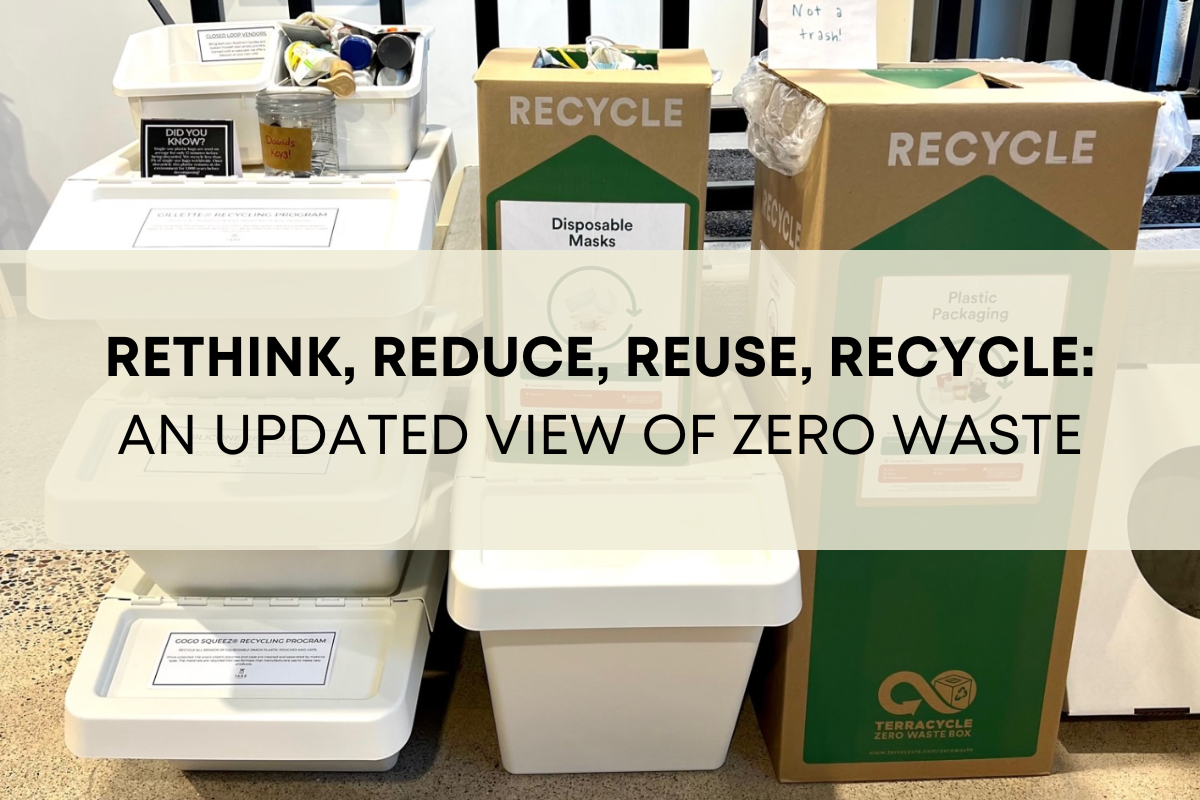Rethink, Reduce, Reuse, Recycle: An Updated View of Zero Waste

Having a goal of living a zero-waste lifestyle is admirable! If you have conducted a trash audit you have started to see common items that are ending up in your trash, and have probably started thinking about ways to incorporate some easy swaps, divert items away from your garbage through recycling, and possibly even find ways to avoid these items all together.
This journey for most people is a marathon, not a sprint. It will take some time to continue reducing waste in your home and so be patient and keep going! In my experience, after a few months of working to reduce the amount of trash in my home, I have found that the recycling bin is often times even more full than the garbage bin. That means I’m making a positive difference and strides in the right direction, right?
Indeed, recycling items is better than them going into a landfill. However, did you know that there are additional, more upstream ways to try and eliminate waste that are even better than recycling? In this blog, you will learn more about the “Zero Waste Hierarchy”1 and the impact that each category along the pyramid has in the grander scheme of waste reduction.
What is the Zero Waste Hierarchy?
The Zero Waste Hierarchy is an inverted pyramid that identifies, from top to bottom, the different ways to think about prioritizing getting to zero waste. The top section includes closed loop systems. The middle section includes the responsible discarding, recovery or treatment of waste, and the bottom of the pyramid includes the incineration or use of landfill to discard of waste.


Concepts at the Top of the Zero Waste Hierarchy Funnel
To start, let’s look at the definitions of the top of the funnel concepts according to the Zero Waste International Alliance:
In terms of how these concepts apply to your daily life, it may be easier to consider a space in your home, a set of routines you have, or a set of items you purchase. For example, one practical way to think about these concepts is with fashion or clothing.
- Rethink/Redesign: Some forward-thinking clothing brands continue to look for ways that their clothing can be closed loop: the clothing items and materials are designed in a way that they can be used, repaired and then recycled as inputs into more clothing. Purchasing clothing made by these brands is one way you can help promote zero waste.
- Reduce: You as a consumer of clothing may decide that you are going to avoid purchasing many items that are focused around fast fashion and uber trends, and instead focus on purchasing quality, sustainably made clothing items that will last for many years. This type of purchasing behavior often results in purchasing less and therefore you are reducing what you consume, a positive step toward zero waste.

- Reuse/Repair: After you no longer wear an item of clothing, you can bring it to a clothing swap or ensure it is donated to an organization that will ensure the clothing is reused by someone else. In some instances, the item of clothing may just need a fix-it repair, so it can be re-worn or reused by someone else. Check out your local area for mending shops or repair stores. There may be a hidden gem in your area you didn’t even know about!
Recycling and Repurposing Is Also Impactful
The next section of the Zero Waste Hierarchy includes the responsible recycling, recovery or repurposing of waste, and managing residuals. Let’s again look at the definition of these concepts by the Zero Waste international Alliance:
4. Recycle/Compost: Discards are mechanically reprocessed into products or materials or processed to return to the soil.1
5. Material Recovery (or Repurpose): Salvaging materials after attempts to rethink/redesign, reduce, reuse and recycle/compost.1
6. Residuals Management: Handling discarded materials in a way that doesn’t threaten the environment or human health.1
The concept here that will most likely apply to your daily life is recycling and composting. If you have an item that cannot be reused, then recycling and composting are the next best options.
- Recycling/Composting: Here are four tips around recycling:
- Check your municipalities’ rules around recycling and pay attention to the resin numbers on your containers to ensure your items get recycled. If you’re not sure if an item can be recycled, contact your municipality. Contaminated recycling can mean that all of it gets thrown in the landfill!
- Don’t use plastic bags in your recycling bin, empty the items into your recycling receptacle loose.
- For items that cannot go into your curbside recycling, check out Tare Market’s recycling section! We have TerraCycle bins and recycling for things like toothpaste tubes, food pouches and makeup. Additionally (and going back to our clothing example above), if a clothing item is beyond repair, purchase a textile recycling bag that can be filled and sent back to a textile recycling company.

4. Compost. Compost. Compost. If you have food waste, the best thing to do with it is compost. It helps build healthy soil and putting it in your trash to go to the landfill creates even more greenhouse gases. At Tare Market, we have compost bins, filters and bags.
- Materials Recovery or Repurposing: One practical way to think about materials recovery in your daily life is to consider ways to “re-purpose” an item. Sticking with our fashion example, an old piece of fabric or textile can be repurposed for a sewing project, used as a fabric wrap for a gift, or used as napkins or cleaning rags around the house. Get creative with how you can repurpose items!
- Residuals Management: Residuals waste is material treated in a way so it is stabilized in landfills. Although this won’t apply to most people’s daily life, to get an idea of what this means, examples include pulp and paper residuals, wood waste and water treatment. These processes are important to ensure our natural resources continue to be safe for consumption and appropriately preserved.
- Waste that Ends Up in the Landfill: The bottom of the pyramid includes any waste that is incinerated, turned into energy or directed to a landfill. Waste that ends up in a landfill is the least desirable of course since it produces gases such as carbon dioxide, which contribute to climate change. The best option to try and reduce what goes into the landfill is to avoid or “refuse” items that cannot fit into the Zero Waste Hierarchy in any other way.
We hope you gained a baseline understanding of what the Zero Waste Hierarchy is in addition to some helpful tips and ideas around how you can incorporate the concepts into your daily life. First, work to rethink, reduce and reuse/repair, and if these options aren’t possible to incorporate, be sure to recycle/compost and repurpose as much as you can. Let’s go Zero Waste!
- https://zwia.org/zwh/
Recent Blog Posts
Discover more tips on living #ZeroWaste!
-

How to Celebrate Earth Month: 10 Actions to Make a Difference
Earth Month is the perfect time to take action for the planet. In this post, we share 10 simple actions you can take this month to celebrate Earth Month and reduce your ecologic...
Read more -

Why Choose a Plastic-Free, Zero-Waste Lifestyle?
Plastic waste is everywhere, but small swaps can make a big impact. Reduce single-use plastic, shop in bulk, and choose sustainable alternatives. Tare Market is here to help you...
Read more -

Celebrating Women Makers: Women-Owned Brands at Tare Market
Celebrate International Women’s Day with Tare Market by supporting women-owned brands that are making a difference in sustainability and entrepreneurship. From eco-friendly clea...
Read more




